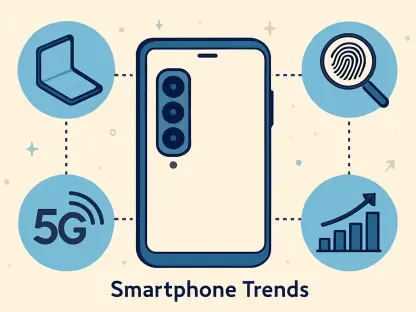As the mobile app industry surges into a transformative era in 2025, the convergence of artificial intelligence (AI) and cutting-edge monetization strategies is reshaping how developers and marketers engage with users. With billions of apps vying for attention in an increasingly crowded digital space, staying ahead demands more than just innovation—it requires a deep understanding of evolving user expectations, skyrocketing advertising costs, and stringent privacy demands. This landscape is further complicated by shrinking attention spans, pushing the industry to adopt smarter, more personalized approaches. AI stands at the forefront, driving hyper-tailored experiences, while novel revenue models and community-building tactics redefine growth. This article explores the dynamic trends propelling mobile apps forward, offering insights into how technology and strategy intersect to create sustainable success in a competitive market. Dive into the forces shaping this vibrant ecosystem and discover what it takes to thrive amid rapid change.
AI-Powered Personalization: Redefining Engagement
The rise of AI as a cornerstone of mobile app development has fundamentally altered the way users interact with digital platforms. By leveraging sophisticated algorithms, apps now predict user preferences with remarkable precision, delivering tailored content that feels uniquely personal. Fitness applications, for instance, analyze individual workout data to craft bespoke exercise plans, while entertainment platforms suggest shows or music based on past behavior. Such customization has led to significant spikes in user engagement, with some developers noting double-digit growth in daily active users. The power of AI lies in its ability to adapt interfaces and notifications dynamically, ensuring every interaction resonates. However, this personalization must navigate the tightrope of privacy concerns, as users grow wary of data overreach. Striking a balance between delivering value and respecting boundaries remains a critical challenge for developers aiming to maintain trust.
Beyond the surface-level benefits, AI-driven personalization is becoming a competitive necessity in a saturated market. Apps that fail to offer customized experiences risk losing users to rivals who prioritize individual needs over generic solutions. The technology not only boosts initial engagement but also plays a pivotal role in retention by anticipating user churn and intervening with targeted prompts or offers. Reports indicate that retention rates can improve by as much as 30% when AI is thoughtfully integrated. Yet, compliance with global privacy regulations adds layers of complexity—developers must ensure transparency in data usage while avoiding invasive tactics. As AI continues to evolve, its role in crafting seamless, meaningful experiences will likely deepen, setting a new benchmark for what users expect from mobile apps. The focus remains on harnessing this technology ethically to foster loyalty without crossing ethical lines.
Monetization Evolution: Crafting Sustainable Revenue
Monetization strategies in the mobile app space have undergone a dramatic shift, moving far beyond traditional in-app purchases to embrace a diverse array of revenue models. Subscription services, often paired with freemium offerings, have gained traction as users seek ongoing value over one-time transactions. Meanwhile, mobile commerce integrations allow apps to serve as direct shopping platforms, streamlining purchases within the user journey. Emerging technologies like Web3 introduce novel opportunities, such as NFT-based rewards, which appeal to niche audiences eager for digital ownership. These innovations reflect a broader push to diversify income streams in response to market saturation. However, the challenge lies in maintaining user trust—transparency about data practices, especially with AI-driven marketing, is non-negotiable to prevent alienation and ensure long-term viability.
The evolution of monetization also demands a delicate balance between profitability and user experience. Overloading apps with aggressive ads or paywalls can drive users away, while under-monetizing risks financial instability for developers. Successful apps are those that integrate revenue models seamlessly, ensuring they enhance rather than disrupt the user journey. For instance, offering premium features through subscriptions while keeping core functionalities free has proven effective across categories like productivity and entertainment. Additionally, as AI-generated content becomes a staple in marketing, clarity in how user data fuels these efforts is paramount to avoid backlash. Looking ahead, the apps that thrive will be those that prioritize ethical monetization, aligning revenue goals with user satisfaction to build lasting relationships and sustainable growth in a competitive arena.
Tackling Advertising Challenges with Strategic Innovation
With advertising costs climbing at an alarming rate—up 25% year-over-year—mobile app marketers are compelled to rethink conventional approaches to user acquisition. Broad, high-budget campaigns are giving way to precision-targeted ads that deliver immediate value to potential users. Platforms like TikTok and Instagram Reels have become hotspots for short-form video content, capturing fleeting attention spans in mere seconds with compelling visuals and messages. Moreover, augmented reality (AR) advertisements, such as virtual product try-ons in e-commerce apps, are slashing bounce rates by offering immersive experiences that encourage organic sharing. This shift underscores a critical need to balance paid advertising with cost-effective, authentic strategies that amplify reach without draining budgets in an increasingly expensive digital ad landscape.
The pivot to smarter advertising also reflects a deeper understanding of user behavior in a crowded market. Marketers are prioritizing campaigns that resonate emotionally or practically, ensuring ads feel less like interruptions and more like solutions. AR and interactive formats not only engage users but also foster word-of-mouth promotion, reducing reliance on paid channels. This approach is particularly vital as user acquisition costs continue to soar, pushing developers to seek organic growth avenues to complement traditional advertising. Data from industry analyses suggests that apps integrating these innovative ad formats see higher conversion rates at lower costs. The key takeaway is clear: adaptability in advertising strategies, blending creativity with efficiency, will determine which apps cut through the noise to secure a loyal user base amid fierce competition.
Community and Analytics: Pillars of Organic Growth
Building vibrant communities around mobile apps has emerged as a powerful catalyst for growth, transforming users into active advocates without the hefty price tag of traditional marketing. By integrating social features and encouraging user-generated content (UGC), apps create ecosystems where engagement fuels virality. Rewards for sharing content or inviting friends have proven effective, especially in competitive niches like productivity and gaming, where community feedback drives rapid iteration. No-code development tools further empower smaller teams to adapt quickly based on user input, ensuring apps remain relevant and responsive. This community-led approach not only reduces acquisition costs but also fosters a sense of belonging, turning casual users into long-term champions who amplify an app’s reach through authentic endorsements.
Complementing community efforts, AI-powered analytics are revolutionizing how developers scale their apps with precision. By automating up to half of creative testing and optimizing campaigns in real time, these tools provide actionable insights into user acquisition costs and lifetime value. Such data-driven decision-making is indispensable in saturated markets where every marketing dollar must yield measurable returns. Analytics also enable cross-platform SEO strategies, helping apps tap into the billions of daily searches beyond app stores to capture wider audiences. The synergy of community engagement and robust analytics offers a sustainable growth model, allowing developers to predict trends, minimize churn, and allocate resources effectively. Together, these elements form a bedrock for apps aiming to stand out in a landscape where differentiation is increasingly challenging.
Future-Proofing Apps with Emerging Technologies
The integration of cutting-edge technologies like 5G and wearables is poised to transform mobile app interactions, paving the way for seamless, cross-device experiences that elevate user satisfaction. With 5G enabling faster, more reliable connections, apps can deliver richer content and real-time functionalities, from immersive gaming to instant data syncing. Wearables, meanwhile, extend app utility by integrating health tracking or notifications directly into daily life, creating a more cohesive digital ecosystem. These advancements promise to redefine user expectations, pushing developers to innovate continuously. However, they also bring heightened scrutiny on privacy, as users demand assurance that their data remains secure across interconnected platforms. Navigating this terrain requires a commitment to ethical design alongside technological progress.
As these technologies reshape the mobile app landscape, the role of privacy-focused innovation cannot be overstated. AI-generated content, increasingly used in marketing, offers transformative potential but must be paired with transparent practices to prevent user distrust. Developers are tasked with anticipating future shifts—potentially spanning from 2025 to 2027—by building adaptable frameworks that can incorporate new tools without compromising user experience. The emphasis on ethical implementation extends to monetization and engagement strategies, ensuring that advancements enhance rather than exploit user interactions. Ultimately, the apps that will lead the market are those that embrace emerging tech while prioritizing user-centric values. Adaptability, underpinned by a balance of innovation and responsibility, stands as the guiding principle for sustaining growth in an ever-evolving digital environment.









